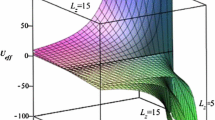Abstract
The success of the moving puncture method for the numerical simulation of black hole systems can be partially explained by the properties of stationary solutions of the 1 + log coordinate condition. We compute stationary 1 + log slices of the Schwarzschild spacetime in isotropic coordinates in order to investigate the coordinate singularity that the numerical methods have to handle at the puncture. We present an alternative integration method to obtain isotropic coordinates that simplifies numerical integration and that gives direct access to a local expansion in the isotropic radius near the puncture. Numerical results have shown that certain quantities are well approximated by a function linear in the isotropic radius near the puncture, while here we show that in some cases the isotropic radius appears with an exponent that is close to but unequal to one.
Similar content being viewed by others
References
Campanelli M., Lousto C.O., Marronetti P., Zlochower Y.: Phys. Rev. Lett. 96, 111101 (2006)
Baker J.G., Centrella J., Choi D.I., Koppitz M., van Meter J.: Phys. Rev. Lett. 96, 111102 (2006)
Brandt S., Brügmann B.: Phys. Rev. Lett. 78(19), 3606 (1997)
Beig R., O’Murchadha N.: Class. Quantum Grav. 11, 419 (1994)
Beig R., O’Murchadha N.: Class. Quantum Grav. 13, 739 (1996)
Dain S., Friedrich H.: Comm. Math. Phys. 222, 569 (2001)
Misner C., Wheeler J.: Ann. Phys. (N.Y.) 2, 525 (1957)
Brill D.R., Lindquist R.W.: Phys. Rev. 131, 471 (1963)
Hannam M., Husa S., Pollney D., Brügmann B., Ó Murchadha N.: Phys. Rev. Lett. 99, 241102 (2007)
Brown J.D.: Phys. Rev. D 77, 044018 (2008)
Garfinkle D., Gundlach C., Hilditch D.: Class. Quant. Grav. 25, 075007 (2008)
Hannam M., Husa S., Ohme F., Brügmann B., O’Murchadha N.: Phys. Rev. D 78, 064020 (2008)
Hannam M., Husa S., Ó Murchadha N., Brügmann B., González J.A., Sperhake U.: J. Phys. Conf. Ser. 66, 012047 (2007)
Baumgarte T.W., Naculich S.G.: Phys. Rev. D75, 067502 (2007)
Buchman L.T., Bardeen J.M.: Phys. Rev. D 72, 124014 (2005)
Ohme, F.: Slicing conditions in spherical symmetry. Diploma Thesis, Universität Jena (2007)
Brown, J.D.: (2007). ArXiv:0705.3845 [gr-qc]
Alcubierre M., Brügmann B., Diener P., Koppitz M., Pollney D., Seidel E., Takahashi R.: Phys. Rev. D 67, 084023 (2003)
Brügmann B.: Int. J. Mod. Phys. 8, 85 (1999)
York, Jr. J.W., in Sources of Gravitational Radiation:ed. by L. Smarr, pp. 83–126. Cambridge University Press, Cambridge, (1979)
Baumgarte T.W. et al.: Class. Quant. Grav. 26, 085007 (2009)
Bona C., Massó J., Seidel E., Stela J.: Phys. Rev. Lett. 75, 600 (1995)
Press W.H., Flannery B.P., Teukolsky S.A., Vetterling W.T.: Numerical Recipes, 2nd edn. Cambridge University Press, New York (1992)
Gundlach C., Martin-Garcia J.M.: Phys. Rev. D 74, 024016 (2006)
van Meter J.R., Baker J.G., Koppitz M., Choi D.I.: Phys. Rev. D 73, 124011 (2006)
Cantor M.: J. Math. Phys. 20, 1741 (1979)
Author information
Authors and Affiliations
Corresponding author
Additional information
This paper is dedicated to the memory of Jürgen Ehlers. I have known JE for a number of years, in particular during his time as founding director of the Albert Einstein Institute in Potsdam. JE was the mentor of my habilitation thesis in 1996, and I am deeply thankful for many insightful discussions. JE combined great breadth and physical intuition with sharp analytical thought. His example inspired me to look beyond the numerical methods and results of numerical relativity to the analytic foundations. For example, while at the AEI, S. Brandt and I introduced “puncture initial data” for the numerical construction of general multiple black hole spacetimes [3]. While the puncture construction starts with an analytic trick of the sort that numerical relativists may devise, it is fair to say that the keen interest in analytical relativity created by JE at the AEI induced us to push our analysis one step further. As a result [3] connects to [26] for an existence and uniqueness proof for such black hole initial data, using weighted Sobolev spaces (see also [4–6]). The present work and its predecessors [9–12] represent an example where numerical experiments led to the discovery of an analytic solution for the 1 + log gauge for the Schwarzschild solution, and the present result, although modest, is of the type which I believe JE would have appreciated.
Rights and permissions
About this article
Cite this article
Brügmann, B. Schwarzschild black hole as moving puncture in isotropic coordinates. Gen Relativ Gravit 41, 2131–2151 (2009). https://doi.org/10.1007/s10714-009-0818-6
Received:
Accepted:
Published:
Issue Date:
DOI: https://doi.org/10.1007/s10714-009-0818-6




